Study on the Spatial and Temporal Characteristics of Mesoscale Drought in China under Future Climate Change Scenarios
Abstract
:1. Introduction
2. Materials and Methods
2.1. Sources of Observed Data and Study Area
2.2. Selection of RCMs for Future Projected Precipitation Data
2.3. Drought Indices
2.4. Regionalization of Droughts
- (1)
- The number of drought events observed in a particular period (FRQ);
- (2)
- The number of drought events with durations greater than 24 months (FRQ24);
- (3)
- The maximum observed severity across the observed episodes (Smax);
- (4)
- The maximum duration in months across the drought episodes (Dmax).
2.5. Cluster Analysis
2.6. Trend and Periodicity Analysis
3. Results
3.1. Identification of Drought Clusters
3.2. Performance Evaluation of RCMs for Drought Simulation
3.3. Trend Analyses of Drought Severity and Frequency
3.4. The Variation in the Drought Area Ratio
3.5. Analyses of the DHI Variations
3.6. Periodicity Analyses
4. Discussion
4.1. Spatial and Temporal Characteristics of Drought in China
4.2. Impact of Selection of the Drought Index on Drought Characteristics
4.3. The Impact of Carbon Emission on Drought
4.4. Periodicity Analysis
4.5. Uncertainties Analysis
5. Conclusions
- (1)
- Three drought indices (SPI, SP*ETI, and SPEI) in the historical period are close, diverging in the future period.
- (2)
- Droughts in China over different periods have regional characteristics. All drought indices show similar variation trends. Droughts in most parts of Xinjiang Province, northern Tibet, and western Qinghai Province show a significantly increasing trend.
- (3)
- The effect of climate change on the drought cycle is not significant. With the increase in greenhouse gas concentrations, drought in central and western China will become more severe, and it will spread to the eastern areas in China. A higher emission concentration will lead to an increase in the potential evaporation rate, and the corresponding evapotranspiration will lead to a higher drought hazard.
- (4)
- in the study of drought changes in the future, more consideration should be given to comprehensively reflecting the regional drought characteristics by using various drought indices related to temperature and evapotranspiration.
Supplementary Materials
Author Contributions
Funding
Institutional Review Board Statement
Informed Consent Statement
Data Availability Statement
Acknowledgments
Conflicts of Interest
References
- Xu, K.; Yang, D.; Yang, H.; Li, Z.; Qin, Y.; Shen, Y. Spatio-temporal variation of drought in China during 1961–2012: A climatic perspective. J. Hydrology 2015, 526, 253–264. [Google Scholar] [CrossRef]
- Nicholson, E.S. Climatic and environmental change in Africa during the last two centuries. Clim. Chang. 2001, 17, 123–144. [Google Scholar] [CrossRef] [Green Version]
- Shanahan, T.M.; Overpeck, J.T.; Anchukaitis, K.J.; Beck, J.W.; Cole, J.E.; Dettman, D.L.; Peck, J.A.; Scholz, C.A.; King, J.W. Atlantic forcing of persistent drought in West Africa. Science 2009, 324, 377–380. [Google Scholar] [CrossRef] [PubMed] [Green Version]
- Dai, A.; Trenberth, K.E.; Qian, T. A global dataset of Palmer drought severity index for 1870–2002: Relationship with soil moisture and effects of surface warming. J. Hydrometeorol. 2004, 5, 1117–1130. [Google Scholar] [CrossRef]
- Chen, H.; Sun, J. Anthropogenic warming has caused hot droughts more frequently in China. J. Hydrol. 2017, 544, 306–318. [Google Scholar] [CrossRef]
- Yao, N.; Li, L.C.; Feng, P.Y.; Feng, H.; Liu, D.L.; Liu, Y.; Jiang, K.T.; Hu, X.T.; Li, Y. Projections of drought characteristics in China based on a standardized precipitation and evapotranspiration index and multiple GCMs. Sci. Total. Environ. 2020, 704, 135245. [Google Scholar] [CrossRef]
- Dogan, S.; Berktay, A.; Singh, V.P. Comparison of multi-monthly rainfall-based drought severity indices, with application to semi-arid Konya closed basin, Turkey. J. Hydrol. 2012, 470–471, 255–268. [Google Scholar] [CrossRef]
- Zhang, D.E.; Liu, C. The distribution of drought and flood in China in recent 500 years. Meteorol. Mon. 1993, 19, 41–45. [Google Scholar]
- Yang, J.; Gong, D.; Wang, W.; Hu, M.; Mao, R. Extreme drought event of 2009/2010 over southwestern China. Meteorol. Atmos. Phys. 2012, 115, 173–184. [Google Scholar] [CrossRef]
- Sun, J. Record-breaking SST over mid-North Atlantic and extreme high temperature over the Jianghuai–Jiangnan region of China in 2013. Chin. Sci. Bull. 2014, 59, 3465–3470. [Google Scholar] [CrossRef]
- Wang, H.; He, S. The north China/ Northeastern Asia severe summer drought in 2014. J. Clim. 2015, 28, 6667–6681. [Google Scholar] [CrossRef]
- Nastos, P.T.; Politi, N.; Kapsomenakis, J. Spatial and temporal variability of the Aridity Index in Greece. Atmos. Res. 2013, 119, 140–152. [Google Scholar] [CrossRef]
- Zhang, L.; Zhou, T. Drought over East Asia: A Review. J. Clim. 2015, 28, 3375–3399. [Google Scholar] [CrossRef]
- Thilakarathne, M.; Sridhar, V. Characterization of future drought conditions in the Lower Mekong River Basin. Weather Clim. Extrem. 2017, 17, 47–58. [Google Scholar] [CrossRef]
- Masud, M.B.; Khaliq, M.N.; Wheater, H.S. Future changes to drought characteristics over the Canadian Prairie Provinces based on NARCCAP multi-RCM ensemble. Clim. Dyn. 2016, 48, 2685–2705. [Google Scholar] [CrossRef]
- Zarch, M.A.A.; Sivakumar, B.; Malekinezhad, H.; Sharma, A. Future aridity under conditions of global climate change. J. Hydrol. 2017, 554, 451–469. [Google Scholar] [CrossRef]
- Oguntunde, P.G.; Abiodun, B.J.; Lischeid, G. Impacts of climate change on hydro-meteorological drought over the Volta Basin, West Africa. Glob. Planet. Chang. 2017, 155, 121–132. [Google Scholar] [CrossRef]
- Gupta, V.; Jain, M.K. Investigation of multi-model spatiotemporal mesoscale drought projections over India under climate change scenario. J. Hydrol. 2018, 567, 489–509. [Google Scholar] [CrossRef]
- Dai, A. Increasing drought under global warming in observations and models. Nat. Clim. Chang. 2012, 3, 52–58. [Google Scholar] [CrossRef]
- Aghakouchak, A.; Cheng, L.; Mazdiyasni, O.; Farahmand, A. Global warming and changes in risk of concurrent climate extremes: Insights from the 2014 California drought. Geophys. Res. Lett. 2014, 41, 8847–8852. [Google Scholar] [CrossRef] [Green Version]
- Chen, H.; Sun, J. Changes in drought characteristics over China using the standardized precipitation evapotranspiration index. J. Clim. 2015, 28, 5430–5447. [Google Scholar] [CrossRef]
- Palmer, W.C. (Ed.) Meteorological Drought; US Department of Commerce; Weather Bureau: Washington, DC, USA, 1965.
- McKee, T.B.; Doesken, N.J.; Kleist, J. The relationship of drought frequency and duration to time scales. In Proceedings of the Eighth Conference on Applied Climatology, Anaheim, CA, USA, 17–22 January 1993; pp. 179–183. [Google Scholar]
- Vicente-Serrano, S.M.; Begueria, S.; Lopez-Moreno, J.I. A multiscalar drought index sensitive to global warming: The standardized precipitation evapotranspiration index. J. Clim. 2010, 23, 1696–1718. [Google Scholar] [CrossRef] [Green Version]
- Vicente-Serrano, S.M.; Beguería, S.; López-Moreno, J.I.; Angulo, M.; El Kenawy, A. A New Global 0.5° Gridded Dataset (1901–2006) of a Multiscalar Drought Index: Comparison with Current Drought Index Datasets Based on the Palmer Drought Severity Index. J. Hydrometeorol. 2010, 11, 1033–1043. [Google Scholar] [CrossRef] [Green Version]
- Vicente-Serrano, S.M.; Lasanta, T.; Gracia, C. Aridification determines changes in forest growth in Pinus halepensis forests under semiarid Mediterranean climate conditions. For. Ecol. Manag. 2010, 150, 614–628. [Google Scholar] [CrossRef]
- Beguería, S.; Vicente-Serrano, S.M.; Reig, F.; Latorre, B. Standardized precipitation evapotranspiration index (SPEI) revisited: Parameter fitting, evapotranspiration models, tools, datasets and drought monitoring. Int. J. Climatol. 2014, 34, 3001–3023. [Google Scholar] [CrossRef] [Green Version]
- Wang, L.; Yu, H.; Yang, M.; Yang, R.; Gao, R.; Wang, Y. A drought index: The standardized precipitation evapotranspiration runoff index. J. Hydrol. 2019, 571, 651–668. [Google Scholar] [CrossRef]
- Maccioni, P.; Kossida, M.; Brocca, L.; Moramarco, T. Assessment of the drought hazard in the Tiber River Basin in Central Italy and a comparison of new and commonly used meteorological indicators. J. Hydrol. Eng. 2015, 20, 05014029. [Google Scholar] [CrossRef]
- Svoboda, M.; LeComte, D.; Hayes, M.; Heim, R.; Gleason, K.; Angel, J.; Rippey, B.; Tinker, R.; Palecki, M.; Stooksbury, D.; et al. The drought monitor. Bull. Amer. Meteor. Soc. 2002, 83, 1181–1190. [Google Scholar] [CrossRef] [Green Version]
- Keyantash, J.A.; Dracup, J.A. An aggregate drought index: Assessing drought severity based on fluctuations in the hydrologic cycle and surface water storage. Water Resour. Res. 2004, 40, W09304. [Google Scholar] [CrossRef] [Green Version]
- Kao, S.; Govindaraju, R.S. A copula-based joint deficit index for droughts. J. Hydrol. 2010, 380, 121–134. [Google Scholar] [CrossRef]
- Hao, Z.C.; Aghakouchak, A. Multivariate Standardized Drought Index: A parametric multi-index model. Adv. Water Resour. 2013, 57, 12–18. [Google Scholar] [CrossRef] [Green Version]
- Li, L.C.; She, D.X.; Zheng, H.; Lin, P.R.; Yang, Z.L. Elucidating diverse drought characteristics from two meteorological drought indices (SPI and SPEI) in China. J. Hydrometeorol. 2020, 21, 1513–1530. [Google Scholar] [CrossRef]
- Zhang, L.; Xu, Y.L.; Meng, C.C.; Li, X.H.; Liu, H.; Wang, C.G. Comparison of statistical and dynamic downscaling techniques in generating high-resolution temperatures in China from CMIP5 GSMs. J. Appl. Meteorol. Climatol. 2020, 59, 207–235. [Google Scholar] [CrossRef]
- Zhang, L.X.; Zhou, T.J.; Chen, X.L.; Wu, P.L.; Christidis, N.; Lott, F.C. The late spring drought of 2018 in South China. Bull. Am. Meteorol. Soc. 2020, 101, S59–S64. [Google Scholar] [CrossRef] [Green Version]
- Piao, S.L.; Fang, J.Y.; Liu, H.Y.; Zhu, B. NDVI-indicated decline in desertification in China in the past two decades. Geophys. Res. Lett. 2005, 32, L06402. [Google Scholar] [CrossRef]
- Jia, B.H.; Wang, Y.Y.; Xie, Z.H. Responses of the terrestrial carbon cycle to drought over China: Modeling sensitivities of the interactive nitrogen and dynamic vegetation. Ecol. Model. 2018, 368, 52–68. [Google Scholar] [CrossRef]
- Shi, F.Z.; Wu, X.C.; Li, X.Y.; Wang, P.; Yang, X.F.; Li, Y.Q.; Jiang, X.F.; Pei, T.T.; Bai, Y.; Hao, B.Y.; et al. Seasonal divergent tree growth trends and growth variability along drought gradient over Northeastern China. Forests 2019, 10, 39. [Google Scholar] [CrossRef] [Green Version]
- Zhao, J.Q.; Zhang, Q.; Zhu, X.D.; Shen, Z.X.; Yu, H.Q. Drought risk assessment in China: Evaluation framework and influencing factors. Geogr. Sustain. 2020, 1, 220–228. [Google Scholar] [CrossRef]
- Fang, W.; Huang, S.Z.; Huang, Q.; Huang, G.H.; Wang, H.; Leng, G.Y.; Wang, L.; Li, P.; Ma, L. Bivariate probabilistic quantification of drought impacts on terrestrial vegetation dynamics in mainland China. J. Hydrol. 2019, 577, 123980. [Google Scholar] [CrossRef]
- Ding, Y.B.; Xu, J.T.; Wang, X.W.; Cai, H.J.; Zhou, Z.Q.; Sun, Y.N.; Shi, H.Y. Propagation of meteorological to hydrological drought for different climate regions in China. J. Environ. Manag. 2021, 283, 111980. [Google Scholar] [CrossRef] [PubMed]
- Daneshvar, M.R.M.; Bagherzadeh, A.; Khosravi, M. Assessment of drought hazard impact on wheat cultivation using standardized precipitation index in Iran. Arab. J. Geosci. 2013, 6, 4463–4473. [Google Scholar] [CrossRef]
- Wang, M.T.; Wang, X.; Huang, W.H.; Zhang, Y.F.; Ma, J. Temporal and spatial distribution of seasonal drought in Southwest of China on relative moisture index. Trans. Chin. Soc. Agric. Eng. 2012, 28, 85–92. [Google Scholar]
- Zhou, Y.L.; Liu, L.; Zhou, P.; Jin, J.L.; Li, J.Q.; Wu, C.G. Identification of drought and frequency analysis of drought characteristics based on palmer drought severity index model. Trans. Chin. Soc. Agric. Eng. 2014, 30, 174–184. [Google Scholar]
- Huang, W.H.; Sui, Y.; Yang, X.G.; Dai, S.W.; Qu, H.H.; Li, M.S. Spatio-temporal characteristics of crop drought in southern China based on drought index of continuous days without available precipitation. Trans. Chin. Soc. Agric. Eng. 2014, 30, 125–135. [Google Scholar]
- Chen, S.D.; Zhang, L.P.; Tang, R.X.; Yang, K.; Huang, Y.Q. Analysis on temporal and spatial variation of drought in Henan Province based on SPEI and TVDI. Trans. Chin. Soc. Agric. Eng. 2017, 33, 126–132. [Google Scholar]
- Zeng, Z.; Wu, W.; Li, Z.; Zhou, Y.; Guo, Y.; Huang, H. Agricultural drought risk assessment in southwest China. Water 2019, 11, 1064. [Google Scholar] [CrossRef] [Green Version]
- Taylor, K.E.; Stouffer, R.J.; Meehl, G.A. An Overview of CMIP5 and the Experiment Design. Bull. Am. Meteorol. Soc. 2012, 93, 485–498. [Google Scholar] [CrossRef] [Green Version]
- Sperber, K.R.; Annamalai, H.; Kang, I.S.; Kitoh, A.; Moise, A.; Turner, A.; Wang, B.; Zhou, T. The Asian summer monsoon: An intercomparison of CMIP5 vs. CMIP3 simulations of the late 20th century. Clim. Dyn. 2013, 41, 2711–2744. [Google Scholar] [CrossRef]
- Woldemeskel, F.M.; Sharma, A.; Sivakumar, B.; Mehrotra, R. A framework to quantify GCM uncertainties for use in impact assessment studies. J. Hydrol. 2014, 519, 1453–1465. [Google Scholar] [CrossRef]
- McSweeney, C.F.; Jones, R.G.; Lee, R.W.; Rowell, D.P. Selecting CMIP5 GCMs for downscaling over multiple regions. Clim. Dyn. 2015, 44, 3237–3260. [Google Scholar] [CrossRef] [Green Version]
- Jiang, Y.; Xu, X.; Liu, H.; Wang, W.; Dong, X. Projection of surface wind by CMIP5 and CMIP3 in China in the 21st century. J. Meteorol. Environ. 2018, 34, 56–63. [Google Scholar]
- Wu, H. Projection of the spatial and temporal variation characteristics of surface air temperature over central Asia in the next 50 years in the Beijing Climate Center Climate System Model V1.1. Acta Meteorol. Sin. 2013, 71, 261–274. [Google Scholar]
- Stagge, J.H.; Tallaksen, L.M.; Gudmundsson, L.; Loo, A.F.V.; Stahl, K. Candidate Distributions for Climatological Drought Indices (SPI and SPEI). Int. J. Climatol. 2015, 35, 4027–4040. [Google Scholar] [CrossRef]
- Thornthwaite, C.W. An approach toward a rational classification of climate. Geogr. Rev. 1948, 38, 55–94. [Google Scholar] [CrossRef]
- USDA. Technical Release No.21: Irrigation Water Requirement; USDA: Washington, DC, USA, 1970.
- Saaty, T.L. A scaling method for priorities on hierarchical structures. J. Math. Psychol. 1977, 15, 234–281. [Google Scholar] [CrossRef]
- Burn, D.H. Evaluation of regional flood frequency analysis with a region of influence approach. Water Resour. Res. 1990, 26, 2257–2265. [Google Scholar] [CrossRef]
- Ridolfi, E.; Rianna, M.; Trani, G.; Alfonso, L.; Di Baldassarre, G.; Napolitano, F.; Russo, F. A new methodology to define homogeneous regions through an entropy based clustering method. Adv. Water Resour. 2016, 96, 237–250. [Google Scholar] [CrossRef]
- Rao, A.R.; Srinivas, V.V. Regionalization of watersheds by fuzzy cluster analysis. J. Hydrol. 2006, 318, 57–79. [Google Scholar] [CrossRef]
- Rao, A.R.; Srinivas, V.V. Regionalization of watersheds by hybrid-cluster analysis. J. Hydrol. 2006, 318, 37–56. [Google Scholar] [CrossRef]
- Goyal, M.K.; Gupta, V. Identification of homogeneous rainfall regimes in northeast region of India using fuzzy cluster analysis. Water Resour. Manag. 2014, 28, 4491–4511. [Google Scholar] [CrossRef]
- Macqueen, J.B. Some methods for classification and analysis of multivariate observations. In Proceedings of the Fifth Berkeley Symposium on Mathematical Statistics and Probability, Los Angeles, CA, USA, 21 June–18 July 1965. [Google Scholar]
- Dunn, J.C. Well-Separated Clusters and Optimal Fuzzy Partitions. J. Cybern. 1974, 4, 95–104. [Google Scholar] [CrossRef]
- Rousseeuw, P.J. Silhouettes: A graphical aid to the interpretation and validation of cluster analysis. J. Comput. Appl. Math. 1987, 20, 53–65. [Google Scholar] [CrossRef] [Green Version]
- Davies, D.L.; Bouldin, D.W. A Cluster Separation Measure. IEEE Trans. Pattern Anal. Mach. Intell. 1979, PAMI-1, 224–227. [Google Scholar] [CrossRef]
- Razavi, S.; Vogel, R. Prewhitening of Hydroclimatic Time Series and Implications for Inferred Change and Variability Across Time Scales. J. Hydrol. 2018, 557, 109–115. [Google Scholar] [CrossRef]
- Gocic, M.; Trajkovic, S. Analysis of changes in meteorological variables using Mann-Kendall and Sen’s slope estimator statistical tests in Serbia. Glob. Planet. Chang. 2013, 100, 172–182. [Google Scholar] [CrossRef]
- Hamed, K.H. Trend detection in hydrologic data: The Mann–Kendall trend test under the scaling hypothesis. J. Hydrol. 2008, 349, 350–363. [Google Scholar] [CrossRef]
- Moreira, E.E.; Martins, D.; Pereira, L.S. Assessing drought cycles in SPI time series using a Fourier analysis. Nat. Hazards Earth Syst. Sci. 2015, 15, 571–585. [Google Scholar] [CrossRef] [Green Version]
- Lenderink, G.; Buishand, A.; Deursen, W.V. Estimates of future discharges of the river Rhine using two scenario methodologies: Direct versus delta approach. Hydrol. Earth Syst. Sci. 2007, 11, 1145–1159. [Google Scholar] [CrossRef]
- Ma, B.; Zhang, B.; Jia, L.; Huang, H. Conditional distribution selection for SPEI-daily and its revealed meteorological drought characteristics in China from 1961 to 2017. Atmos. Res. 2020, 246, 105108. [Google Scholar] [CrossRef]
- Yang, W.; Long, D.; Bai, P. Impacts of future land cover and climate changes on runoff in the mostly afforested river basin in North China. J. Hydrol. 2019, 570, 201–219. [Google Scholar] [CrossRef]
- Chen, H. Projected change in extreme rainfall events in China by the end of the 21st century using CMIP5 models. Chin. Sci. Bull. 2013, 58, 1462–1472. [Google Scholar] [CrossRef] [Green Version]
- Lin, L.; Gettelman, A.; Feng, S.; Fu, Q. Simulated climatology and evolution of aridity in the 21st century. J. Geophys. Res.-Atmos. 2015, 120, 5795–5815. [Google Scholar] [CrossRef]
- Lv, Y.; Guo, J.; Yim, S.H.-L.; Yun, Y.; Yin, J.; Liu, L.; Zhang, Y.; Yang, Y.; Yan, Y.; Chen, D. Towards understanding multi-model precipitation predictions from CMIP5 based on China hourly merged precipitation analysis data. Atmos. Res. 2020, 231, 104671. [Google Scholar] [CrossRef]
- Zhang, Y.; You, Q.; Chen, C.; Ge, J. Impacts of climate change on streamflows under RCP scenarios: A case study in Xin River Basin, China. Atmos. Res. 2016, 178–179, 521–534. [Google Scholar] [CrossRef]
- Oguntunde, P.G.; Lischeid, G.; Abiodun, B.J. Impacts of climate variability and change on drought characteristics in the Niger River Basin, West Africa. Stoch. Environ. Res. Risk Assess. 2018, 32, 1017–1034. [Google Scholar] [CrossRef]
- Zhou, J.; Wang, Y.; Su, B.; Wang, A.; Tao, H.; Zhai, J.; Kundzewicz, Z.W.; Jiang, T. Choice of potential evapotranspiration formulas influences drought assessment: A case study in China. Atmos. Res. 2020, 242, 104979. [Google Scholar] [CrossRef]
- Wang, L.; Li, Q.; Mao, X.Z.; Bi, H.; Yin, P. Interannual sea level variability in the Pearl River Estuary and its response to El Nio–Southern Oscillation. Glob. Planet. Chang. 2018, 162, 163–174. [Google Scholar] [CrossRef]
- Feng, J.; Li, J. Influence of El Niño Modoki on spring rainfall over south China. J. Geophys. Res. 2011, 116, D13102. [Google Scholar] [CrossRef]
- Yue, T.; Zhao, N.; Fan, Z.; Li, J.; Chen, C.; Lu, Y.; Wang, C.; Xu, B.; Wilson, J. CMIP5 downscaling and its uncertainty in China. Glob. Planet. Chang. 2016, 146, 30–37. [Google Scholar] [CrossRef]
- Cao, L.; Calderia, K. Atmospheric carbon dioxide removal: Long-term consequences and commitment. Environ. Res. Lett. 2010, 5, 024011. [Google Scholar] [CrossRef]
- Boucher, O.; Halloran, P.; Burke, E.J.; Doutriaux-Boucher, M.; Jones, C.D.; Lowe, J.; Ringer, M.A.; Robertson, E.; Wu, P. Reversibility in an earth system model in response to co2 concentration changes. Environ. Res. Lett. 2012, 7, 024013. [Google Scholar] [CrossRef]
- MacDougall, A.H. Reversing climate warming by artificial atmospheric carbon-dioxide removal: Can a holocene-like climate be restored? Geophys. Res. Lett. 2013, 40, 5480–5485. [Google Scholar] [CrossRef]
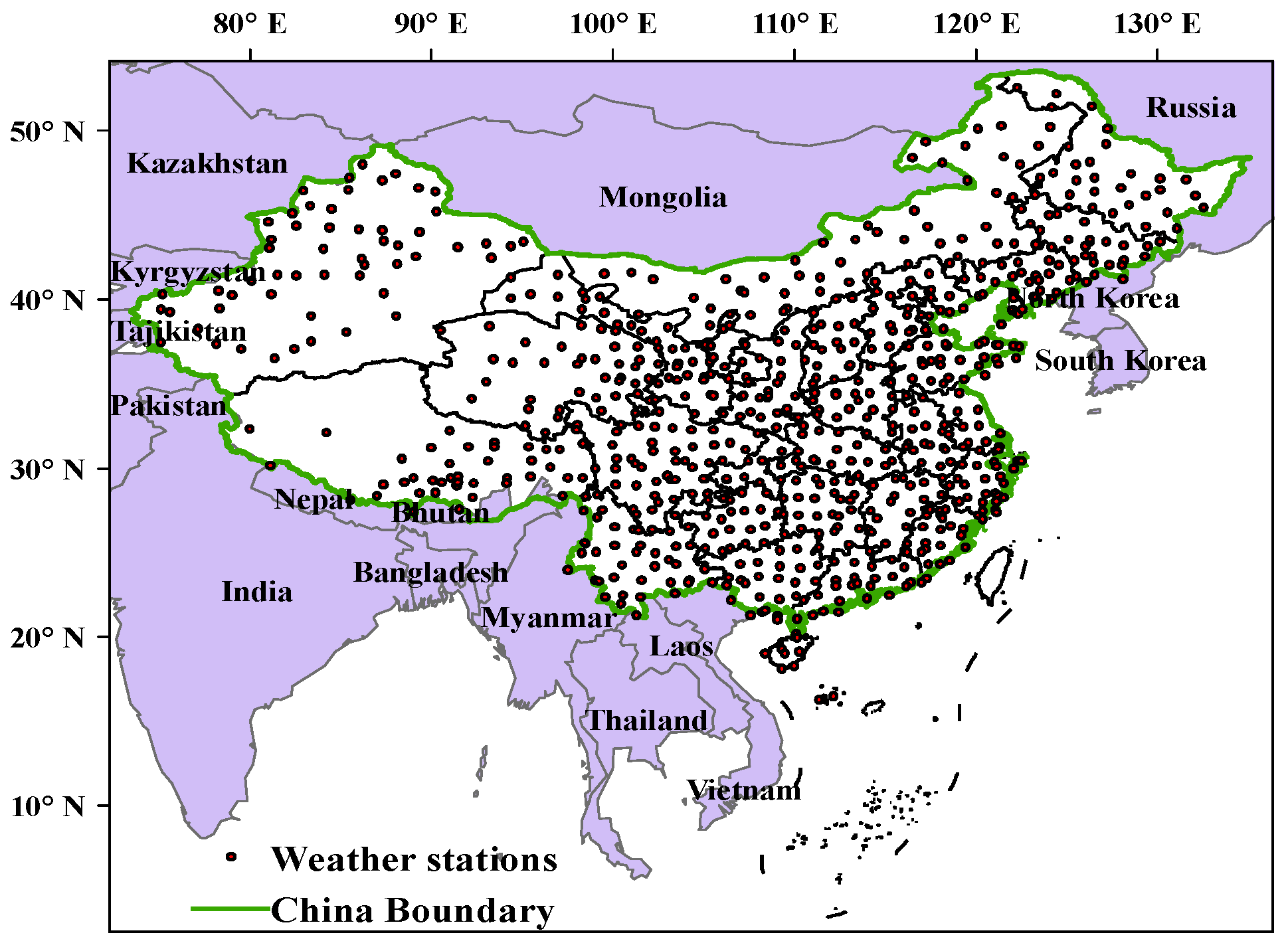


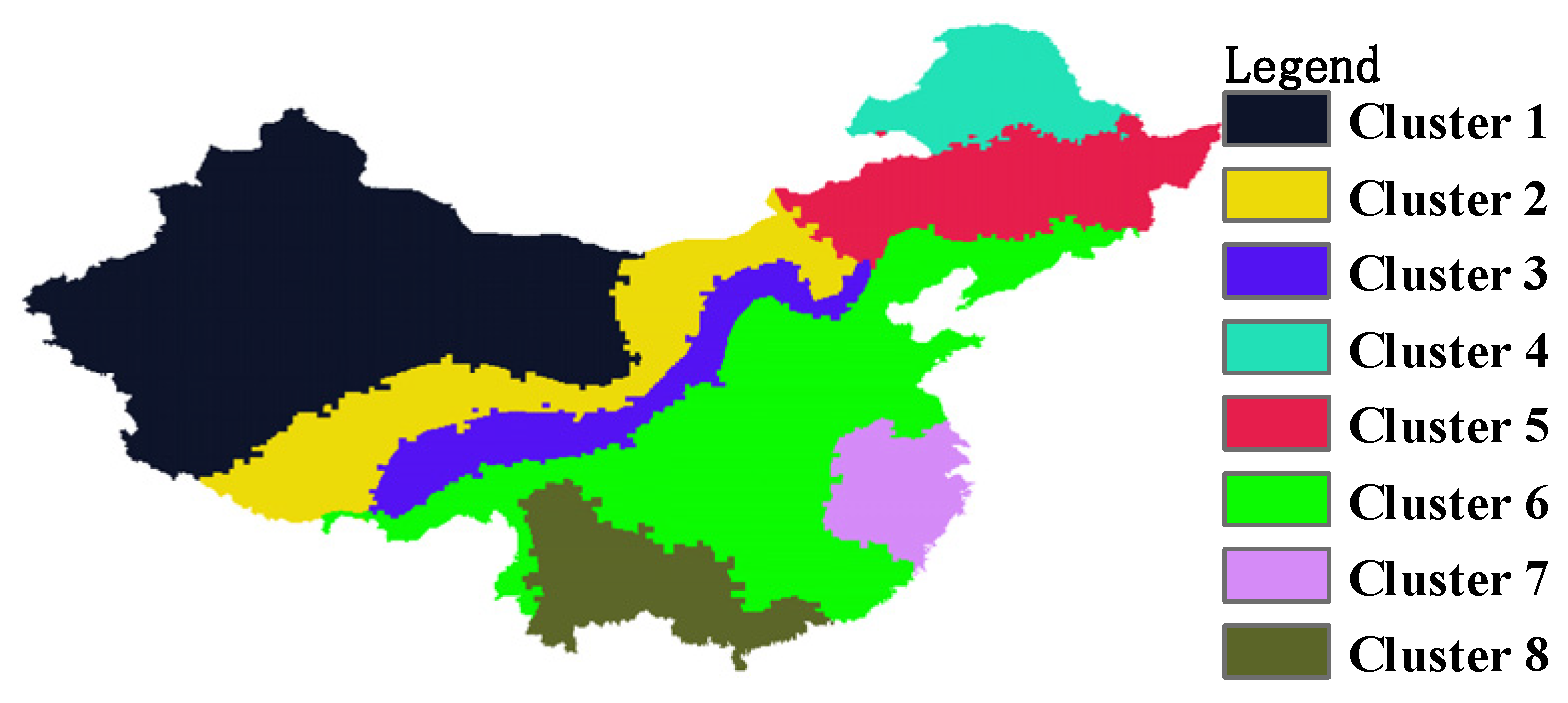
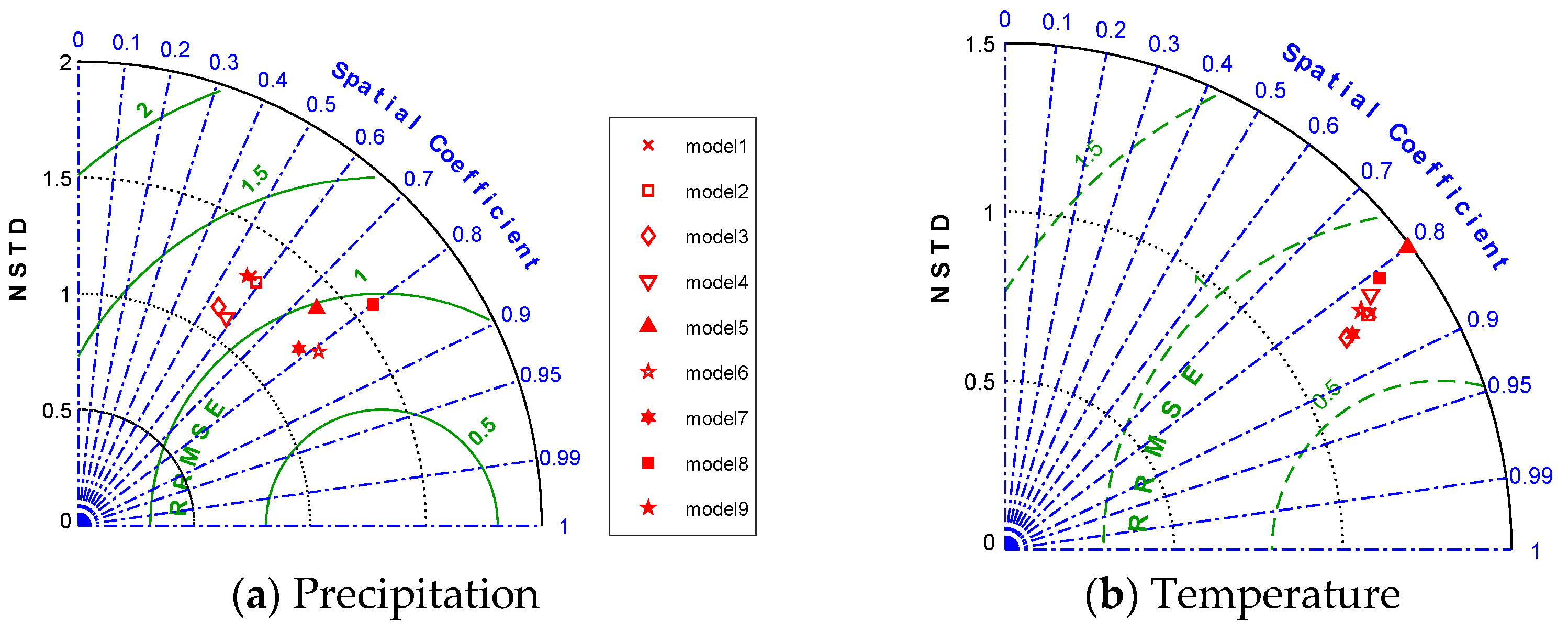



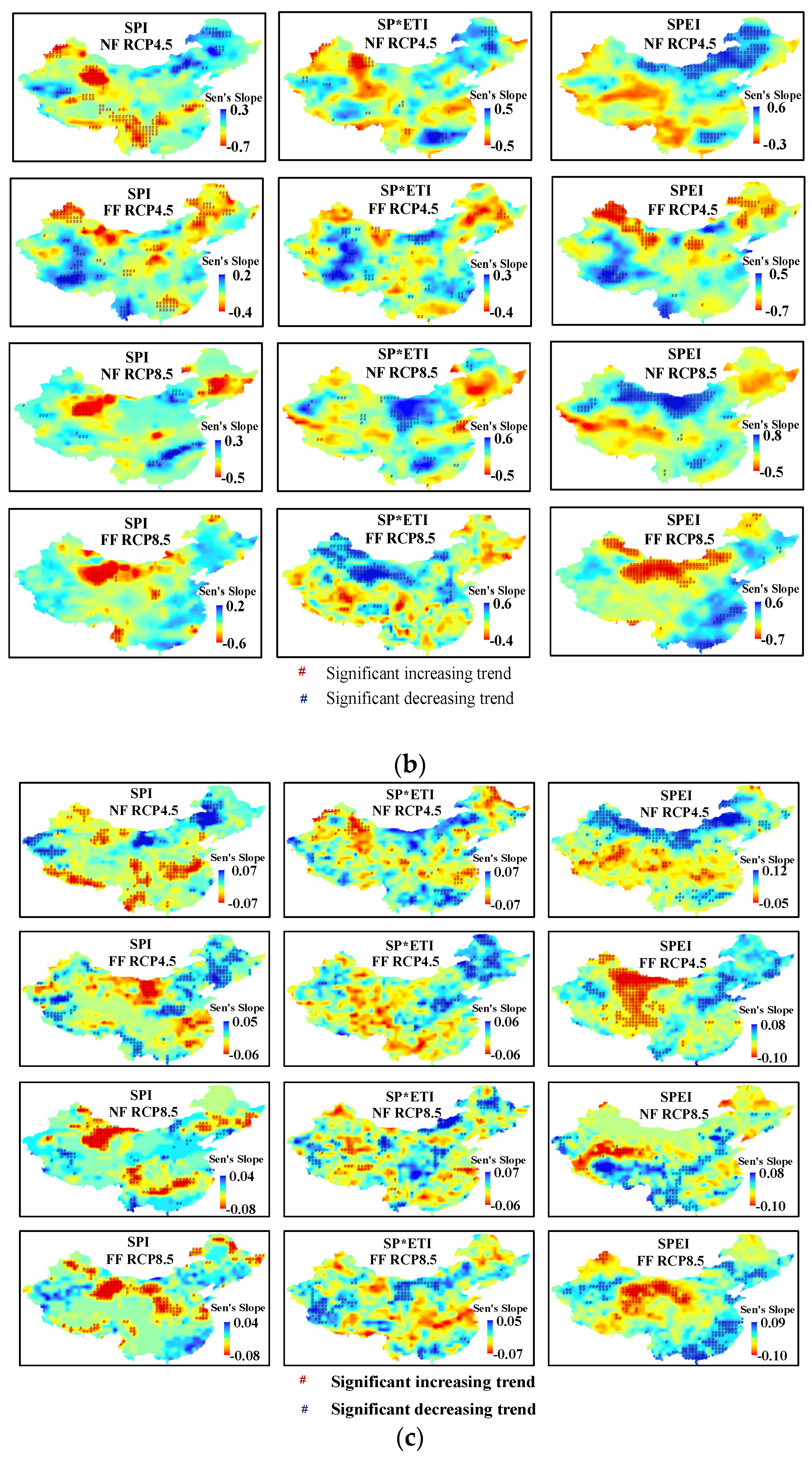

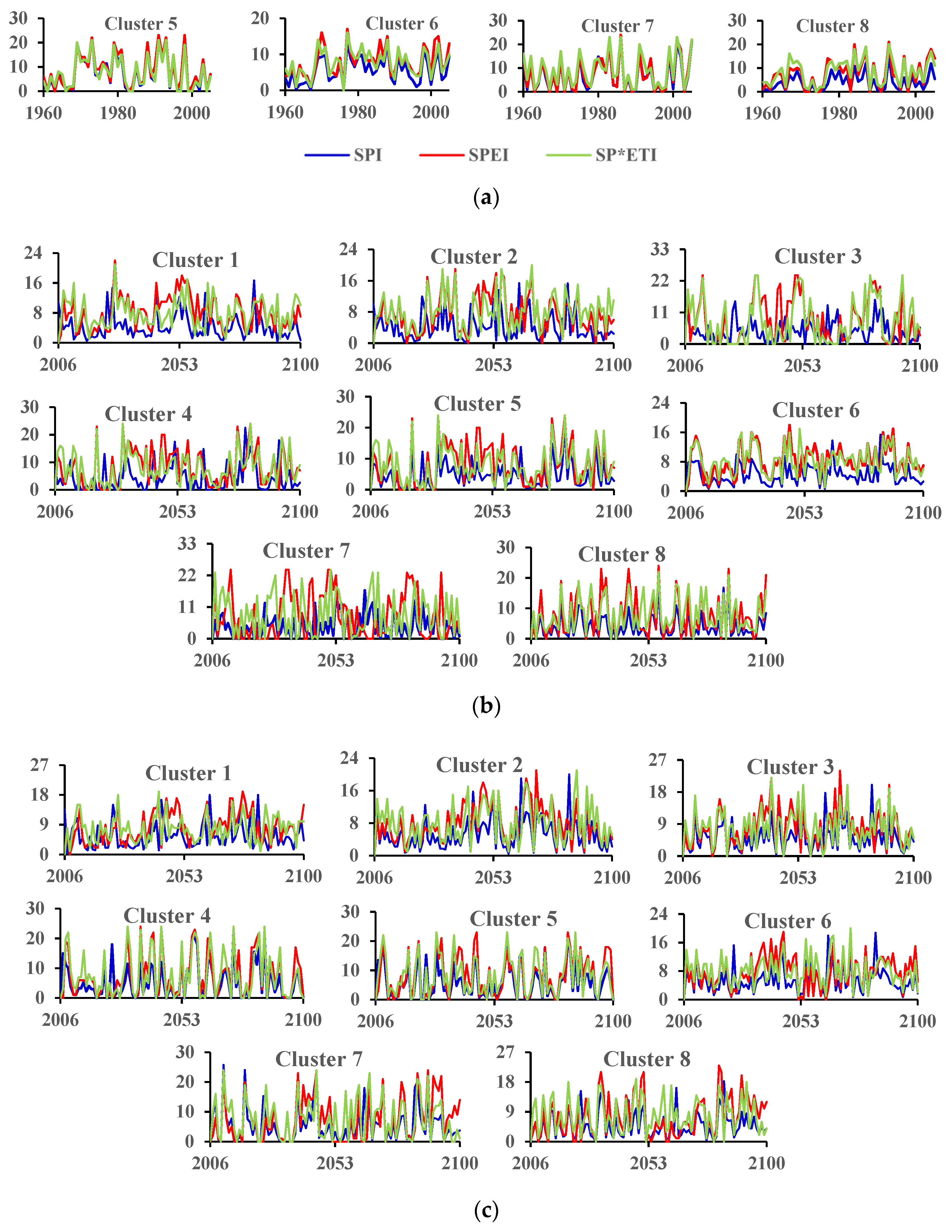
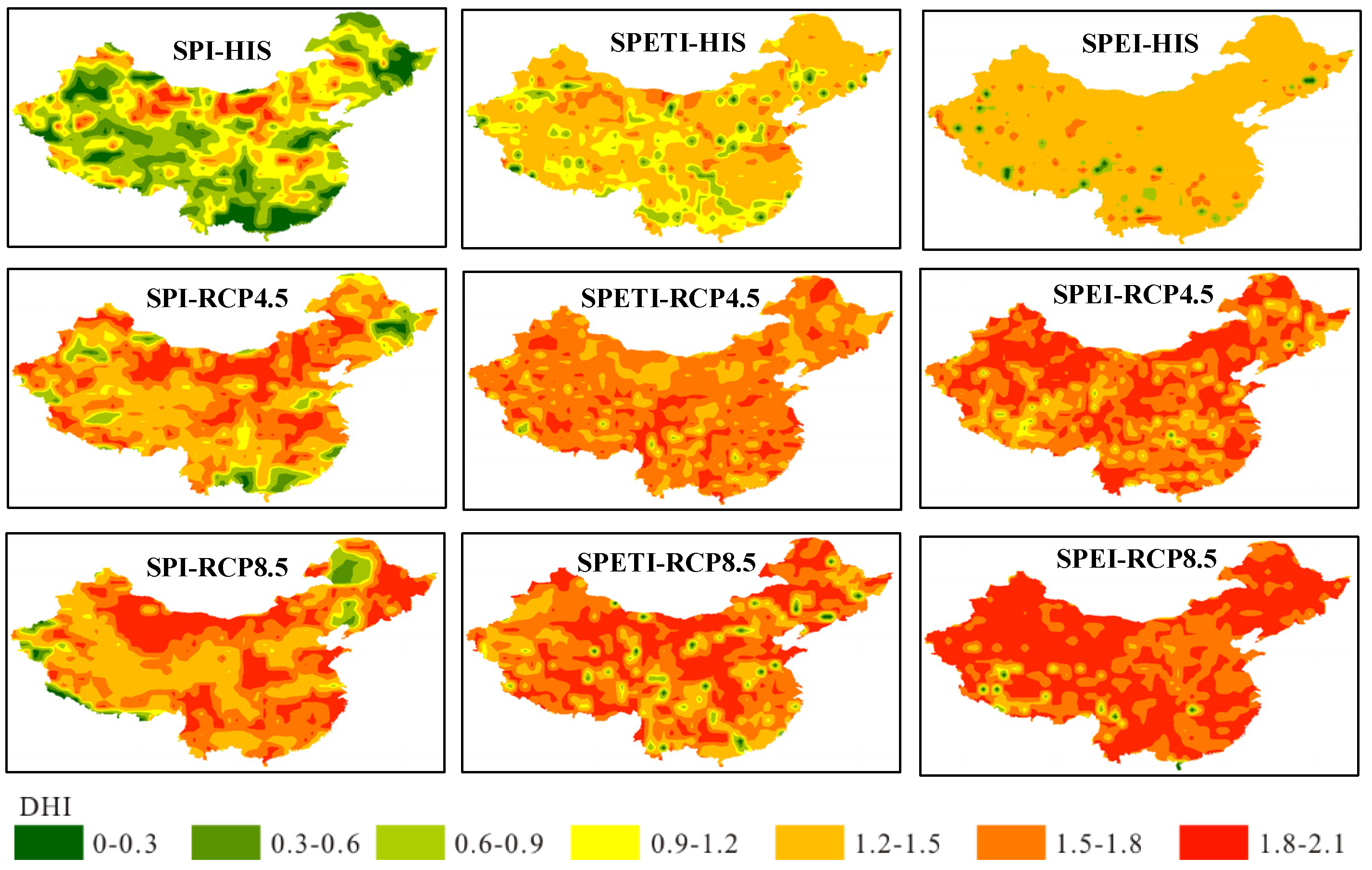

| Model No. | Institute | Driving Model |
|---|---|---|
| model1 | Max Planck Institute for Meteorology(Germany) | MPI-ESM-MR |
| model2 | Max Planck Institute for Meteorology(Germany) | MPI-ESM-LR |
| model3 | NOAA Geophysical Fluid Dynamics Laboratory (USA) | GFDL-ESM2M |
| model4 | NOAA Geophysical Fluid Dynamics Laboratory (USA) | GFDL-CM3 |
| model5 | Centre National de Recherches Météorologiques and Centre Européen de Recherche et Formation Avancée en Calcul Scientifique (France) | CNRM-CM5 |
| model6 | UK Met Office Hadley Centre (UK) | HadGEM2-ES |
| model7 | UK Met Office Hadley Centre (UK) | HadGEM2-AO |
| model8 | University of Tokyo, National Institute for Environmental Studies, and Japan Agency for Marine-Earth Science and Technology(Japan) | MIROC5 |
| model9 | National Centre for Atmospheric Research(USA) | CCSM4 |
| Sen’s Slope | ||||||
|---|---|---|---|---|---|---|
| Precipitation | Potential Evapotranspiration | Temperature | ||||
| RCP 4.5 | RCP 8.5 | RCP 4.5 | RCP 8.5 | RCP 4.5 | RCP 8.5 | |
| Cluster 1 | 0.883 | 1.42 | 1.023 | 2.491 | 0.038 | 0.079 |
| Cluster 2 | 1.581 | 2.233 | 0.887 | 1.844 | 0.033 | 0.068 |
| Cluster 3 | 1.699 | 2.006 | 0.943 | 1.893 | 0.034 | 0.069 |
| Cluster 4 | 0.714 | 1.509 | 1.466 | 2.833 | 0.043 | 0.088 |
| Cluster 5 | 0.636 | 1.494 | 1.757 | 3.307 | 0.041 | 0.083 |
| Cluster 6 | 2.778 | 3.416 | 2.241 | 5.515 | 0.036 | 0.072 |
| Cluster 7 | 3.956 | 2.611 | 2.831 | 9.092 | 0.033 | 0.074 |
| Cluster 8 | 2.85 | 3.037 | 2.555 | 6.944 | 0.034 | 0.067 |
| Modified Mann–Kendall’s test | ||||||
| Cluster 1 | 1 | 1 | 1 | 1 | 1 | 1 |
| Cluster 2 | 1 | 1 | 1 | 1 | 1 | 1 |
| Cluster 3 | 1 | 1 | 1 | 1 | 1 | 1 |
| Cluster 4 | 0 | 1 | 1 | 1 | 1 | 1 |
| Cluster 5 | 0 | 1 | 1 | 1 | 1 | 1 |
| Cluster 6 | 1 | 1 | 1 | 1 | 1 | 1 |
| Cluster 7 | 1 | 1 | 1 | 1 | 1 | 1 |
| Cluster 8 | 1 | 1 | 1 | 1 | 1 | 1 |
| Cluster 1 | Cluster 2 | Cluster 3 | Cluster 4 | ||||||
|---|---|---|---|---|---|---|---|---|---|
| Sev | Freq | Sev | Freq | Sev | Freq | Sev | Freq | ||
| SPI | Hist | −14 | −3 | 5 | 3 | 12 | 4 | −8 | −2 |
| RCP4.5NF | −16 | −2 | −9 | −2 | −12 | −3 | 9 | 0 | |
| RCP4.5FF | −14 | −2 | −1 | −4 | −16 | −2 | −30 | 0 | |
| RCP8.5NF | −14 | −4 | −2 | −2 | −6 | −3 | −9 | −4 | |
| RCP8.5FF | −28 | −3 | −27 | −3 | −26 | −4 | −19 | −4 | |
| SP*ETI | Hist | −14 | −3 | 4 | 4 | 9 | 4 | −5 | −2 |
| RCP4.5NF | −9 | −1 | 9 | 2 | 9 | 0 | 39 | −2 | |
| RCP4.5FF | −12 | −1 | 3 | −2 | −15 | −1 | −29 | 5 | |
| RCP8.5NF | 11 | −1 | 32 | −1 | 28 | −1 | 21 | 2 | |
| RCP8.5FF | 37 | 0 | 14 | 0 | 25 | −1 | 4 | −2 | |
| SPEI | Hist | −12 | −1 | 26 | 6 | 34 | 8 | 1 | 0 |
| RCP4.5NF | 23 | 6 | 37 | 6 | 29 | 2 | 83 | 8 | |
| RCP4.5FF | −27 | −6 | 5 | −5 | −24 | −4 | −62 | 3 | |
| RCP8.5NF | 71 | −2 | 65 | 1 | 50 | 3 | 32 | −4 | |
| RCP8.5FF | −35 | −2 | −46 | −5 | −29 | −3 | −44 | −1 | |
| Cluster 5 | Cluster 6 | Cluster 7 | Cluster 8 | ||||||
| Sev | Freq | Sev | Freq | Sev | Freq | Sev | Freq | ||
| SPI | Hist | −6 | 0 | 10 | 3 | 18 | 0 | 11 | 1 |
| RCP4.5NF | 8 | 1 | −10 | −4 | −10 | −2 | −21 | −4 | |
| RCP4.5FF | −20 | 0 | −16 | −2 | −6 | −5 | −2 | −1 | |
| RCP8.5NF | −23 | −5 | −7 | −3 | 4 | −5 | −9 | −3 | |
| RCP8.5FF | −11 | −2 | −15 | −3 | −5 | −2 | −17 | −2 | |
| SP*ETI | Hist | −4 | 0 | 8 | 2 | 17 | 0 | 19 | 3 |
| RCP4.5NF | 24 | 2 | 10 | 1 | −10 | −3 | −2 | 3 | |
| RCP4.5FF | −32 | 4 | −14 | 1 | 10 | −1 | −24 | −4 | |
| RCP8.5NF | −26 | 1 | 17 | 0 | 22 | −4 | 20 | −1 | |
| RCP8.5FF | 5 | 0 | 20 | −2 | 8 | −2 | 16 | 0 | |
| SPEI | Hist | 3 | 3 | 23 | 4 | 28 | 1 | 32 | 5 |
| RCP4.5NF | 74 | 11 | 37 | 3 | 28 | 2 | −5 | 5 | |
| RCP4.5FF | −39 | 3 | −18 | 0 | −1 | −3 | −1 | 0 | |
| RCP8.5NF | 14 | 0 | 60 | 1 | 79 | −1 | 65 | 3 | |
| RCP8.5FF | 11 | 5 | 18 | 4 | 65 | 10 | 24 | 9 | |
| Cluster 1 | Cluster 2 | Cluster 3 | Cluster 4 | Cluster 5 | Cluster 6 | Cluster 7 | Cluster 8 | ||||||||||||||||||
|---|---|---|---|---|---|---|---|---|---|---|---|---|---|---|---|---|---|---|---|---|---|---|---|---|---|
| RCP | N | F | T | N | F | T | N | F | T | N | F | T | N | F | T | N | F | T | N | F | T | N | F | T | |
| SPI | 4.5 | 0 | - | 0 | 0 | - | 0 | 0 | - | 0 | 0 | 0 | 0 | 0 | 0 | 0 | 0 | - | 0 | 0 | - | 0 | 0 | 0 | 0 |
| SPI | 8.5 | 0 | 0 | + | + | - | 0 | 0 | 0 | 0 | 0 | - | 0 | 0 | 0 | 0 | 0 | 0 | 0 | 0 | + | 0 | + | + | 0 |
| SPEI | 4.5 | + | - | 0 | 0 | - | 0 | 0 | - | 0 | + | 0 | 0 | + | 0 | 0 | 0 | - | 0 | 0 | - | 0 | 0 | 0 | 0 |
| SPEI | 8.5 | + | 0 | + | + | - | 0 | + | 0 | 0 | 0 | 0 | 0 | 0 | + | 0 | + | + | + | + | + | + | + | + | + |
| SP*ETI | 4.5 | 0 | 0 | 0 | 0 | 0 | 0 | 0 | 0 | 0 | 0 | 0 | 0 | 0 | 0 | 0 | 0 | 0 | 0 | 0 | 0 | 0 | + | 0 | 0 |
| SP*ETI | 8.5 | 0 | + | 0 | 0 | 0 | 0 | 0 | 0 | 0 | 0 | - | 0 | 0 | 0 | 0 | 0 | 0 | 0 | 0 | 0 | 0 | 0 | 0 | 0 |
| Cluster 1 | Cluster 2 | Cluster 3 | Cluster 4 | Cluster 5 | Cluster 6 | Cluster 7 | Cluster 8 | ||
|---|---|---|---|---|---|---|---|---|---|
| SPI | Hist | 1.41 | 1.29 | 1.10 | 1.02 | 1.15 | 1.01 | 1.23 | 1.37 |
| RCP4.5 | 1.51 | 1.55 | 1.61 | 1.42 | 1.38 | 1.48 | 1.47 | 1.13 | |
| RCP8.5 | 1.55 | 1.52 | 1.53 | 1.23 | 1.62 | 1.61 | 1.70 | 1.64 | |
| SPET | Hist | 1.54 | 1.40 | 1.30 | 1.17 | 1.30 | 1.17 | 1.30 | 1.30 |
| RCP4.5 | 1.74 | 1.65 | 1.77 | 1.72 | 1.73 | 1.69 | 1.75 | 1.69 | |
| RCP8.5 | 1.87 | 1.75 | 1.79 | 1.86 | 1.91 | 1.79 | 1.87 | 1.78 | |
| SP*ETI | Hist | 1.61 | 1.56 | 1.55 | 1.45 | 1.55 | 1.48 | 1.62 | 1.58 |
| RCP4.5 | 1.64 | 1.68 | 1.67 | 1.65 | 1.63 | 1.65 | 1.76 | 1.64 | |
| RCP8.5 | 1.69 | 1.69 | 1.63 | 1.75 | 1.65 | 1.62 | 1.64 | 1.78 |
Publisher’s Note: MDPI stays neutral with regard to jurisdictional claims in published maps and institutional affiliations. |
© 2021 by the authors. Licensee MDPI, Basel, Switzerland. This article is an open access article distributed under the terms and conditions of the Creative Commons Attribution (CC BY) license (https://creativecommons.org/licenses/by/4.0/).
Share and Cite
Gong, X.; Du, S.; Li, F.; Ding, Y. Study on the Spatial and Temporal Characteristics of Mesoscale Drought in China under Future Climate Change Scenarios. Water 2021, 13, 2761. https://doi.org/10.3390/w13192761
Gong X, Du S, Li F, Ding Y. Study on the Spatial and Temporal Characteristics of Mesoscale Drought in China under Future Climate Change Scenarios. Water. 2021; 13(19):2761. https://doi.org/10.3390/w13192761
Chicago/Turabian StyleGong, Xinglong, Shuping Du, Fengyu Li, and Yibo Ding. 2021. "Study on the Spatial and Temporal Characteristics of Mesoscale Drought in China under Future Climate Change Scenarios" Water 13, no. 19: 2761. https://doi.org/10.3390/w13192761
APA StyleGong, X., Du, S., Li, F., & Ding, Y. (2021). Study on the Spatial and Temporal Characteristics of Mesoscale Drought in China under Future Climate Change Scenarios. Water, 13(19), 2761. https://doi.org/10.3390/w13192761






